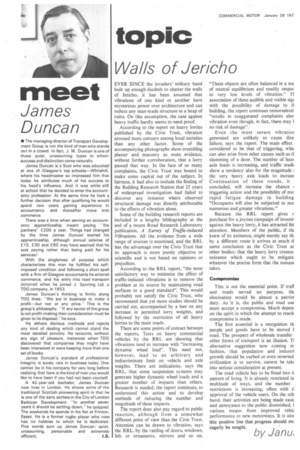topic
Page 46

If you've noticed an error in this article please click here to report it so we can fix it.
Walls of Jericho
EVER SINCE the invaders' military band built Up enough decibels to shatter the walls of Jericho, it has been assumed that vibrations of one kind or another have mysterious power over architecture and can reduce any man-made structure to a heap of ruins. On this assumption, the case against heavy traffic hardly seems to need proof.
According to the report on heavy lorries published by the Civic Trust, vibration aroused more concern among local societies than any other factor. Some of the accompanying photographs show crumbling plaster and masonry as mute evidence, without further corroboration, that a lorry passed that way. In the face of so many complaints, the Civic Trust was bound to make some capital out of the subject. In fairness, it had also to include the finding of the Building Research Station that 25 years of widespread investigation had failed to discover any instance where observed structural damage was directly attributable to the effects of vibration alone.
Some of the building research reports are included in a lengthy bibliography at the end of a recent Road Research Laboratory publication, A Survey of Traffic-induced Vibrations. All the evidence from a wide range of sources is examined, and the RRL has the advantage over the Civic Trust that its approach is more purely objective or scientific and is not based on opinions or prejudices.
According to the RRL report, "the most satisfactory way to minimize the effect of traffic-induced vibrations is to remove the problem at its source by Maintaining road surfaces to a good standard". This would probably not satisfy the Civic Trust, who recommend that yet more studies should be carried out, accompanied by a ban on any increase in permitted lorry weights, and followed by the restriction of all heavy lorries to the main roads.
There are some points of contact between the reports. Tests on heavy commercial vehicles by the RRL are showing that vibrations tend to increase with "increasing dynamic wheel load". This need not, however, lead to an arbitrary and indiscriminate limit on vehicle and axle weights. There are indications, says the RRL, that some suspension systems may generate higher dynamic wheel loads and a greater number of impacts than others. Research is needed, the report continues, to understand this action and to develop methods of reducing the number and magnitude of these impacts.
The report does also pay regard to public reaction, although from a somewhat different paint of view than the Civic Trust. Attention can be drawn to vibration, says the RRL, by the rattling of .doors windows, lids or ornaments, mirrors and so on.
"These objects are often balanced in a sta of neutral equilibrium and readily respor to very low levels of vibration." TI association of these audible and visible sigi with the possibility of damage to ti building, the report continues remorseless] "results in exaggerated complaints abo vibration even though, in fact, there may I no risk of damage".
Even the most severe vibratior generated are unlikely to cause dire failure, says the report. The main effect considered to be that of triggering, whit can also arise from other causes such as t] slamming of a door. The number of heal axle loads is increasing, and traffic Audi, show a tendency also for the magnitude 1 the very. heavy axle loads to increas Continuation of these trends, it concluded, will increase the chance 1 triggering action and the possibility of mo rapid fatigue damage in building "Occupants will also be subjected to mo numerous and greater vibrations."
Because the RRL report gives r purchase for a joyous campaign of invectil against the heavy lorry, it has attracted litt attention. Members of the public, if th( knew of its existence, might merely say th by a different route it arrives at much t] same conclusion as the Civic Trust ar other bodies: that the heavy lorry creates nuisance which ought to be mitigate whatever the precise form that the nuisam takes.
Compromise This is not the essential point. If trail and roads served no purpose, dm elimination would be almost a patriot duty. As it is, the public and road use must accept a compromise. Much depem on the spirit in which the attempt to reach compromise is made.
The first essential is a recognition th people and goods have to be moved I road. The prospect of wholesale transfer other forms of transport is an illusion. T] alternative suggestion now coming in fashion, that population and industri growth should be curbed or even reversed civilization is to survive, cannot be tato into serious consideration at present.
The road vehicle has to be fitted into f pattern of living. It is already restricted in multitude of ways, and the number restrictions is increasing, often with f approval of the vehicle users. On the oth hand, their activities are being made easic and annoyance to the public diminished, i various means from improved vehic performance to new motorways. It is aloi this positive line that progress should mc eagerly be sought. by Jana
























































































